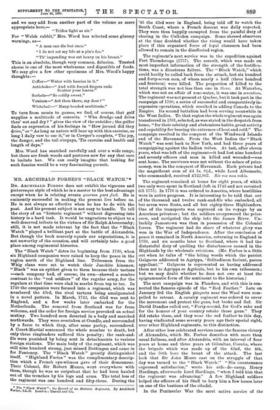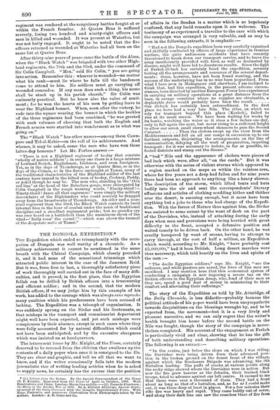MR. ARCHIBALD FORBES'S "BLACK WATCH."*
DR. ARCHIBALD FORBES does not exhibit the vigorous and picturesque style of which he is a master to the best advantage except when he is relating events quorum pars fait. He is eminently successful in making the present live before us. He is not always so effective when he has to do with the past. And his present subject is not easy to handle. To tell the story of an "historic regiment" without digressing into history is a hard task. It would be ungracious to object to a well-deserved tribute to the virtues of Sir Ralph Abercromby; still, it is not made relevant by the fact that the "Black Watch" played a brilliant part at the battle of Alexandria. But though the book scarcely equals our expectations, it is not unworthy of the occasion, and will certainly take a good place among regimental histories.
The "Black Watch" dates its beginning from 1730, when six Highland companies were raised to keep the peace in the region north of the Highland line. Tribesmen from the Whig clans were set to watch their Jacobite kinsmen. " Black " was an epithet given to them because their tartans —each company had, of course, its own—showed a sombre contrast to the "red soldiers" of the regular army, for the regulars at that time were clad in scarlet from top to toe. In 1740 the companies were formed into a regiment, which was numbered the 43rd, the rival tartans being amalgamated in a novel pattern. In March, 1743, the 43rd was sent to England, and a few weeks later embarked for the Netherlands. The removal from Scotland was far from welcome, and the order for foreign service provoked an actual mutiny. Two hundred men deserted in a body and marched northwards. They were overtaken at Oundle, and surrounded by a force to which they, after some parley, surrendered. A Court-Martial sentenced the whole number to death, but only three ringleaders suffered this penalty ; the rank-and- file were punished by being sent in detachments to various foreign stations. The main body of the regiment, which was still nine hundred strong, just missed Dettingen and came in for Fontenoy. The "Black Watch" greatly distinguished itself. "Highland Furies" was the complimentary descrip- tion which a French eye-witness gave of their demeanour. Their Colonel, Sir Robert Munro, went everywhere with them, though he was so corpulent that he had been hauled out of the trenches by his legs and arms. The total loss of the regiment was one hundred and fifty-three. During the
• The "Black Watch": the Record of an Historic Regiment. By Archibald Norbee, LL.D. London Cassell and Co.
'45 the 43rd were in England, being told off to watch the South Coast, where a French descent was daily expected. They were thus happily exempted from the painful duty of sharing in the Cnlloden campaign. Some shrewd observers at the time doubted whether the rising would have taken place if this organised force of loyal clansmen had been allowed to remain in the disaffected region.
The regiment's next service was in the expedition against Fort Ticonderoga (1757). The assault, which was made on most imperfect information of the strength of the fortifica- tions, was a disastrous failure. The "Black Watch," which could hardly be called back from the attack, lost six hundred and forty-seven men, of whom nearly a half (three hundred and fourteen) were killed. The proportion of killed to the total strength was not less than one in three. At Waterloo, which was not an affair of rose-water, it was one in seventeen. The regiment was not present at Quebec, but it took part in the campaign of 1760, a series of successful and comparatively in- expensive operations, which resulted in adding Canada to the Empire. Its second battalion had been serving meanwhile in the West Indies. To that region the whole regiment was again transferred in 1761, selected, as was stated in the despatch from home, "for their sobriety and abstemious habits, great activity and capability for bearing the extremes of heat and cold." The campaign resulted in the conquest of the Windward Islands and of the Havannah. From the West Indies the "Black Watch" was sent back to New York, and had three years of campaigning against the Indian tribes. At last, after eleven years, what was left of the regiment—it had last nine hundred and seventy officers and men in killed and wounded—was sent home. The survivors were not without the solace of prize- money, won in the conquest of Havannah. Each private had the magnificent sum of f.:4 is. 8id., while Lord Albemarle, who commanded, received £122,967. Sic vos non vobis.
The regiment remained at home for eight years, of which two only were spent in Scotland (left in 1713 and not revisited till 1775). In 1776 it was ordered to America, where hostilities were in active progress. It is interesting to be told that out of the thousand and twelve rank-and-file who embarked, all but seven were Scots, and all but eighty-three Highlanders. One of the transports was captured on its voyage by an American privateer ; but the soldiers overpowered the prize- crew, and navigated the ship into the James River. Un- luckily Jamestown was then in possession of the Colonial forces. The regiment had its share of whatever glory was won in the War of Independence. After the conclusion of peace it remained in North America, returning to England in 1789, and six months later to Scotland, where it had the distasteful duty of quelling the disturbances caused in the Highlands by the wholesale evictions. (Mr. Forbes is a little out when he talks of "the biting words which the patriot Galgacus addressed to Agrippa, Solitudinem faciunt, pacem appellant.'" Galgactts is represented as having addressed them not to Agrippa or Agricola, but to his own tribesmen; but we may doubt whether he does not owe at least the epigrammatic form of the sentiment to the historian.)
The next campaign was in Flanders, and with this is con- nected the famous episode of the "Red Feather." Late on January 3rd the English picquets near the Waal were com- pelled to retreat. A cavalry regiment was ordered to cover the movement and protect the guns, but broke and fled. Sir David D andas called out, "Forty-second, for God's sake and for the honour of your country retake those guns." They did retake them, and they wear the red feather to this day, having vindicated some seventy years ago their special right, over other Highland regiments, to this distinction.
After other less celebrated services came the famous victory of Alexandria, which Mr. Forbes describes with more than usual fullness, and after Alexandria, with an interval of four years at home and three years at Gibraltar, Coruna, where the brigade which was made up of the 42nd, the 4th, and the 50th bore the brunt of the attack. The last look that Sir John Moore cast on the struggle of that day was turned to the "Black Watch." "His countenance expressed satisfaction," wrote his aide- de-camp, Henry Hardinge, afterwards Lord Hardinge, "when I told him that the regiment was advancing." A few Highland soldiers helped the officers of his Staff to bury him a few hours later on one of the bastions of the citadel.
In the Peninsular War the most active service of the regiment was rendered at the sanguinary battles fought at or within the French frontier. At Quatre Bras it suffered sevirely, losing two hundred and ninety-eight officers and men in killed and wounded. It was present at Waterloo, but was not hotly engaged. It ought to be noted that the five officers returned as wounded at Waterloo had all been on the same list at Quatre Bras.
After thirty-nine years of peace came the battle of the Alma, when the "Black Watch" was brigaded with two other High- land regiments, the 79th and the 93rd, under the command of Sir Colin Campbell. "Men," said Sir Cohn," you are going into action. Remember this : whoever is wounded—no matter what his rank—must lie where he falls till the bandsmen come to attend to him. No soldiers must go carrying off wounded comrades. If any man does such a thing, his name shall be stuck up in his parish church." Sir Colin was eminently practical. But he knew also the value of senti- ment; for he won the hearts of his men by getting leave to wear the Highland bonnet. When, soon after the victory, he rode into the square wearing the bonnet in which the heckles of the three regiments had been combined, "he was greeted with such volumes of cheering that both the English and French armies were startled into wonderment as to what was going on."
The "Black Watch" has other names—among them Cawn- pore and Tel-el-Kebir--on the roll of its achievements. And whence, it may be asked, come the men who have won these latter-day honours P Let Mr. Forbes answer :—
"There is not a Highland regiment of to-day that consists 'wholly of native soldiers ' ; in every one there is a large mixture of Lowland Scotch, Englishmen, Irishmen, and even foreigners. Yet, as in the days of Ti3onderogs, so at Quatre Bras, so in the days of the Crimea, so in the fierce onslaught at Tamai, many of
the traditional characteristics of the Highland soldier of the last century have inured in the kilted man of to-day, Cockney, Paddy, or yokel though he may be. The men who, standing in the thin red line' at the head of the Balaclava gorge, were objurgated by Colin Campbell in the rough warning words, 'Ninety-third !— Ninety-third ! damn all that eagerness'' were simply the military descendants of the Highlanders who could scarcely be dragged away from the breastworks of Ticonderoga. An older and a more staid regiment than the 93rd, the Black Watch controls its lurid internal fires in the hour of combat under the mask of traditional discipline and a steadfast regimental pride ; but no grander cry was ever heard on a battlefield than the unanimous shout of the 42nd—' Rally roun' the cornel ! '—which rose above the turmoil of the desperate melds at Tamai."



















































 Previous page
Previous page